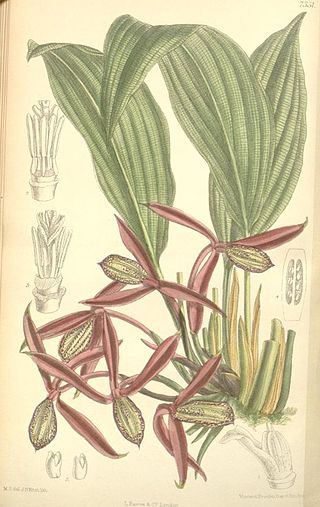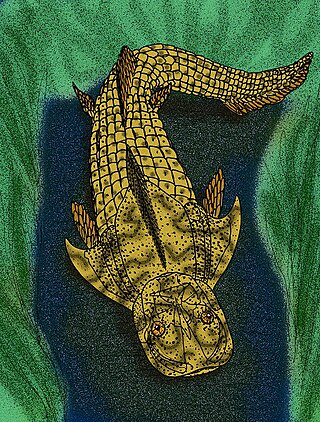
Orchidantha is a genus of flowering plants. In the APG III system, it is placed in the family Lowiaceae, as the sole genus. It includes the plants in the formerly recognised genera Lowia and Protamomum.

Siniperca chuatsi, the mandarin fish, is a species of freshwater ray-finned fish from the family Sinipercidae, the Oriental perches. It is the type species of the genus Siniperca.

The Amblycipitidae are a family of catfishes, commonly known as torrent catfishes. It includes three genera, Amblyceps, Liobagrus, and Xiurenbagrus, and about 36 species.
Oreonectes is a genus of fish in the family Nemacheilidae found in the rivers and caves of Asia. Many of these species are troglobitic.
Sorbitorhynchus is an extinct genus of prehistoric sarcopterygians, or lobe-finned fish. Fossils of this genus of marine lungfish have been found in Guangxi, China. The only described species in this genus is Sorbitorhynchus deleaskitus, but the holotype for this species may show some unusual malformations and thus not be useful for taxonomic or phylogenetic analysis.

The Catostomidae are the suckers of the order Cypriniformes, with about 78 species in this family of freshwater fishes. The Catostomidae are almost exclusively native to North America. The only exceptions are Catostomus catostomus, found in both North America and Russia, and Myxocyprinus asiaticus found only in China. In the Ozarks they are a common food fish and a festival is held each year to celebrate them. The bigmouth buffalo, Ictiobus cyprinellus, can reach an age up to 127 years, making it the oldest known freshwater teleost by more than 50 years.

The Ou River or Oujiang is the second-largest river in the Zhejiang province of eastern China. The river flows 388 kilometers (241 mi) before finally reaching the city of Wenzhou and emptying into the East China Sea, into which it discharges 20.2 billion cubic meters of water annually. Shen Jiang, Jiang Yongjia (永嘉江), and Wenjiang are all former names for this river.
Cophecheilus bamen is a species of fish in the family Cyprinidae, the carps and minnows. It was described in 2011 from a tributary of the Zou-Jiang, a river in the Pearl River drainage in Jingxi County, Guangxi, China. The species name bamen is from Ba Men, the local common name for this and similar fish.
Cao Miao is a variety of Dong (Kam) according to Shi Lin (2012). Dialects include Liushi ("Sixty") Miao 六十苗, Sishi ("Forty") Miao 四十苗, and Ershi ("Twenty") Miao 二十苗. The Flowery Miao 花苗 do not consider themselves to be Cao Miao 草苗, although their language is similar to Sixty Miao and Forty Miao.

Wuttagoonaspis is an extinct genus of primitive arthrodire placoderm fish from the Middle Devonian of Australia. The box-like skull is up to 18 centimeters in length, and the median dorsal plate averages in length about 10 centimeters. It contains two species: the type species Wuttagoonaspis fletcheri, described by Ritchie in 1973, and Wuttagoonaspis milligani, described by Young and Goujet in 2003.

Yiminaspis is an extinct monospecific genus of primitive arthrodire placoderm fish from Emsian-aged marine strata in Yunnan, China. The type species Yiminaspis shenme was named and described in 2008, and is known from a flattened partial skull and portions of the thoracic armor.
Yaoshina is a monospecific genus of freshwater ray-finned fish belonging to the family Gastromyzontidae, commonly called the hillstream loaches, although this also refers to the loaches in the family Balitoridae. The only species in the genus is Yaoshania pachychilus, the panda loach. A loach which is endemic to mountain streams in Jinxiu County, Guangxi in China. This species grows to a length of 5.8 centimetres (2.3 in) SL. This species is monotypic, but it was formerly included in Protomyzon. Juveniles are strikingly coloured in black-and-white, but adults are relatively plain. Y. pachychilus quickly became a popular aquarium fish in the 2010s.
Stenorynchoacrum xijiangensis is a species of cyprinid fish endemic to China where it is only known from Guangxi Province. It occurs in a tributary of the Zhujiang River. This species is the only known member of its genus.
Pseudosinocyclocheilus is a monospecific genus of freshwater ray-finned fish belonging to the family Cyprinidae, the family which includes the carps, barbs, minnows and related fishes. The only species in the genus is Pseudosinocyclocheilus jinxiensis, a species of cavefish endemic to Xiaolong Spring in Jinxi County, Guangxi, China. In 2016, it was proposed that this species should be placed in its own genus Pseudosinocyclocheilus, a move subsequently supported by Catalog of Fishes and FishBase.
Yujiangolepis is an extinct monospecific genus of arthrodire placoderm fish from the Pragian stage of the Devonian period. The type species is Yujiangolepis liujingensis, described from a single incomplete skull roof from the Nakaoling (Nagaoling) Formation of Hengxian, Guangxi, South China. It is one of the more basal members of the order Arthrodira, closely related to Antarctaspis, as shown in the cladogram below:
Simblaspis is an extinct monospecific genus of arthrodire placoderm fish of the Early Devonian period. The type species Aleosteus eganensis was described in 1958, and was found in Pragian strata of the Qasr Limestone in Saudi Arabia.
Heightingtonaspis is an extinct genus of primitive arthrodire placoderm fish from the Devonian period in Great Britain, and currently contains three species.
Anarthraspis is an extinct genus of arthrodire placoderm fishes which lived during the Early Devonian period. It contains two species described in 1932, Anarthraspis chamberlini and Anarthraspis montanus, both found in the Beartooth Butte Formation of Wyoming and Montana, USA, and assigned to the genus in 1934.
Napaisaurus is a genus of iguanodontian ornithopod dinosaur from the Early Cretaceous Xinlong Formation of Guangxi, China. The type and only species is N. guangxiensis.
Baisesaurus is an extinct genus of ichthyosauromorph from the early Triassic (Spathian) Luolou Formation of Guangxi, China. The genus contains a single species, B. robustus, known from a partial postcranial skeleton.






